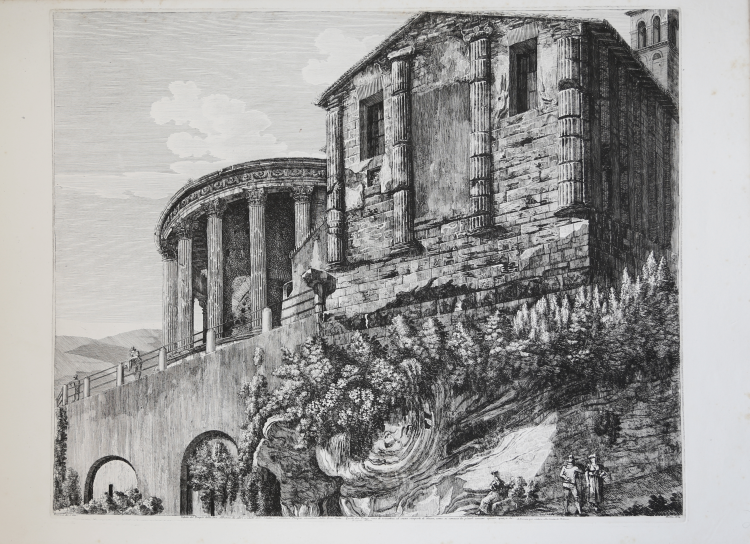



| Reference: | 37109 |
| Author | Luigi ROSSINI |
| Year: | 1824 |
| Zone: | Tivoli |
| Printed: | Rome |
| Measures: | 600 x 500 mm |


| Reference: | 37109 |
| Author | Luigi ROSSINI |
| Year: | 1824 |
| Zone: | Tivoli |
| Printed: | Rome |
| Measures: | 600 x 500 mm |
ANTIQUITIES OUT OF ROME, THE MOST BEAUTIFUL CITIES OF LAZIO
The work was published between 1824 and 1826, divided into four parts including Antichità di Tivoli, di Cora, di Albano e Castel Gandolfo, di Preneste e del Tuscolo. The series was preceded for the first time by an historic-critical introduction with the Explanation of the plates; he also included in the collection some line block plates of plans and monument restorations of great relevance. His preliminary Discorso states that his aim is to reach the highest number of collectors, not just to realize a study book. In his Antichità dei contorni di Roma, Rossini put together in one volume some analogous views Piranesi had already published along the years, with the aim to collect in one work all the antique monuments in the region of Southern Lazio.
In his collection the artist tried to comply with the style of Piranesi, which can be found in the use of chiaroscuro, the choice of the framings and the subjects; even the front pages of every section, the archaeological and architectural elements are confusedly ordered inside the work.
The majority of his subjects, especially the views of Tivoli and the Roman Castles, are still quite close to tradition of the veduta of the previous century. G. F. Gmelin, who had published a collection at the very beginning of the XIX century, can be considered his point of reference for that matter.
|
Luigi Rossini incisore. Vedute di roma 1817 - 1850, catalogo della mostra a cura di L. Gavazzi, M. E. Tottoni, Roma Palazzo Braschi, 7 aprile - 15 luglio 1982. Roma
|
Luigi ROSSINI (Ravenna 1790 - Roma 1875)
|
After training at the Academy of Fine Arts in Bologna, where he studied the engraver Francesco Rosaspina and the painter of decorations Antonio Basoli, in 1813 he won the prize of theRegno Italico for architecture, consisting of a board of three years in Rome at Palazzo Venezia, decisive for his artistic career. Here he realized that his attempts to act as architect failed, discovering instead the engravings of Giovanni Battista Piranesi and, through the work of the great Venetian engraver, he is part of the artistic tradition of engraved view. In 1817 Rossini publishes Frontespizio delle antichità di Roma divise in 40 vedute disegnate dal vero dall'architetto Luigi Rossini, that later reprint with the addition of new plates. In those years he also began working with Bartolomeo Pinelli, which will populate the views by Rossini with his distinctive characters. The fruitful relationship between the two artists will continue until the death of Pinelli took place in 1835. Between 1819 and 1823 he engraved, in 101 tables,Le Antichità Romane ossia raccolta delle più interessanti vedute di Roma antica, disegnate ed incise dall'architetto Luigi Rossini. Between 1824 and 1826 Rossini engraved the etchings Le Antichità dei contorni di Roma, and, two years later, publishes I monumenti più interessanti di Roma dal decimo secolo fìno al secolo decimottavo. In 1829 he returns to his favorite themes of antiquity etchings luce Le porte e le mura del recinto di Roma in 35 tavole. In 1837, Rossini was appointed member of theAcademy of Fine Arts of San Luca, which then become academic merit in 1843.
In 1839 he published Viaggio pittoresco da Roma a Napoli in 80 vedute, a sort of modern tourist guide. He died in Rome on 22 April 1875, after an illness that had forced him to bed paralyzed for five years.
|
|
Luigi Rossini incisore. Vedute di roma 1817 - 1850, catalogo della mostra a cura di L. Gavazzi, M. E. Tottoni, Roma Palazzo Braschi, 7 aprile - 15 luglio 1982. Roma
|
Luigi ROSSINI (Ravenna 1790 - Roma 1875)
|
After training at the Academy of Fine Arts in Bologna, where he studied the engraver Francesco Rosaspina and the painter of decorations Antonio Basoli, in 1813 he won the prize of theRegno Italico for architecture, consisting of a board of three years in Rome at Palazzo Venezia, decisive for his artistic career. Here he realized that his attempts to act as architect failed, discovering instead the engravings of Giovanni Battista Piranesi and, through the work of the great Venetian engraver, he is part of the artistic tradition of engraved view. In 1817 Rossini publishes Frontespizio delle antichità di Roma divise in 40 vedute disegnate dal vero dall'architetto Luigi Rossini, that later reprint with the addition of new plates. In those years he also began working with Bartolomeo Pinelli, which will populate the views by Rossini with his distinctive characters. The fruitful relationship between the two artists will continue until the death of Pinelli took place in 1835. Between 1819 and 1823 he engraved, in 101 tables,Le Antichità Romane ossia raccolta delle più interessanti vedute di Roma antica, disegnate ed incise dall'architetto Luigi Rossini. Between 1824 and 1826 Rossini engraved the etchings Le Antichità dei contorni di Roma, and, two years later, publishes I monumenti più interessanti di Roma dal decimo secolo fìno al secolo decimottavo. In 1829 he returns to his favorite themes of antiquity etchings luce Le porte e le mura del recinto di Roma in 35 tavole. In 1837, Rossini was appointed member of theAcademy of Fine Arts of San Luca, which then become academic merit in 1843.
In 1839 he published Viaggio pittoresco da Roma a Napoli in 80 vedute, a sort of modern tourist guide. He died in Rome on 22 April 1875, after an illness that had forced him to bed paralyzed for five years.
|